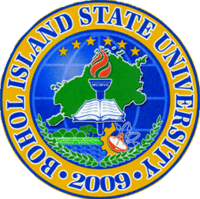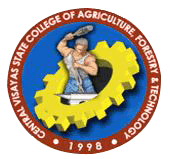Bohol Island State University
| Pamantasang Estado ng Isla ng Bohol | |
 | |
Former names | Central Visayas College of Agriculture, Forestry and Technology (1998-2009) |
|---|---|
| Type | State university |
| Established | 1998 |
| President | Dr. Elpidio T. Magante |
| Location | Tagbilaran City, Bohol, Philippines |
| Campus | 6 |
| Nickname | BISU |
| Website | www.bisu.edu.ph |
The Bohol Island State University (BISU), formerly the Central Visayas State College of Agriculture, Forestry and Technology (CVSCAFT), is a public institution of higher learning in Bohol, Philippines. The institution operates campuses spread throughout the province, with the main campus in Tagbilaran city, Bohol.
By virtue of Republic Act No. 9722 (An Act Converting the Central Visayas State College of Agriculture, Forestry and Technology, its Units and Satellite Campuses in the City of Tagbilaran and in the Municipalities of Bilar, Candijay, Clarin, Calape and Balilihan, All Located in the Province of Bohol to Be Known as the Bohol Island State University (BISU) and Appropriating Funds Therefor) CVSCAFT became BISU, the third university on the province of Bohol and the first State university. The Bill was authored by Congressmen Nerio Uayan, Roberto Cajes, Adam Relson Jala, Cynthia Villar and Junie Cua on February 16, 2009. It was approved by the Senate on August 18, 2009. President Gloria Macapagal-Arroyo signed the bill into law on October 14, 2009, and it took effect on November 9, 2009.
History

Established in 1998, the system was composed of five vocational/technical schools in the province of Bohol. These were the: Bohol Agriculture College (BAC) in Bilar; Bohol School of Arts and Trade (BSAT) in Tagbilaran City; Bohol School of Fisheries (BSF) in Cogtong, Candijay; Clarin School of Fisheries (CSF) in Clarin; and Calape National School of Fisheries (CNFS) in Calape. In 1999, a sixth member was added — the Calape Polytechnic College.
- 1907: Started with a bamboo and nipa shack that housed the class composed of a handful of Grade Five boys taking industrial arts in woodworking. The class was an extension of the Tagbilaran Elementary School. The teacher was an American named George W. Jackson. Years later the class was attached as industrial arts of Bohol Provincial High School.
- 1914: Bohol Trade School was established as a separate school from the Bohol Provincial High School with an initial enrolment of 110 pupils. Boholo Trade school began offering the Secondary Trade Curriculum along with the Intermediate course..
- 1932: The intermediate trade curriculum was dropped. From then on, the school offered the Secondary Trade Curriculum. The first course offered was woodworking, followed by Building Construction and Automechanics. The enrolment reached a little less than 500 until the outbreak of World War II.
- 1948: The four-year Trade course was restored, at the same time keeping the two-year course which was popularly known as the Evening Trade Opportunity Trade Classes (EOTC).
- 1949: The school became co-educational. Female students had a choice of dressmaking, food trades or handicrafts.
- 1950: The FOA-PHILCUSA aid program came to rehabilitate the school. New equipment and hand tools were received to improve the school facilities.
- 1959: Under the Omnibus Act, Bohol Trade School was converted into Bohol School of Arts and Trades. The school offered two-year technical education curriculum,four-year secondary school and EOTC.
- 1968: The school was selected as a Pilot Training Center of the Manpower Training Program under the National Manpower and Youth Council.
- 1975: Authorized to offer the four-year Bachelor of Science in Industrial Technology.
- 1979: Tragedy struck the school on March 24 when fire razed it to ashes. Picking up from the debris of the burned buildings, the school began reconstruction work. In five years, the school rose again with three new buildings.
- 1988: Authorized to offer Technology Courses.
- 1991: Authorized to offer Bachelor in Secondary Education major in THE. Specialization of the school in Civil, Electrical, Refrigeration & Airconditioning and Welding and Fabrication under the Australia Grant in Aid. The school was given equipment and buildings and 11 teachers were sent to Australia for technical training.
- 1993: Authorized to offer Diploma of Technology.
- 1995: Authorized to offer MATVE in the areas of Civil, Drafting & Food Technology.
- 1996: Authorized to offer BS Civil Engineering.
- 1998, Established into a State College on June 22, 1998.
- 1999: Authorized to open BS Mechanical Engineering.
- 2000: Authorized to offer BS Computer and Electrical Engineering.
- 2006: Established extension classes in Balilihan, Bohol, offering BS in Computer Science & BSIT major in Garment Technology. BISU offers new courses such as: BS in Elementary Education, BS Tourism, BS in Office System Management and BS in Entrepreneurship.
Campuses
The BISU Main campus is in Tagbilaran City, though when the school was still known as CVSCAFT, the main campus is in Bilar.
- The Bohol School of Arts and Trade (BSAT) was established in 1906. It started as Bohol Trade School and was converted into a school of arts and trades in 1959.
- The Bohol School of Fisheries (BSF) is in Cogtong, Candijay, 96 kilometers from Tagbilaran City. It was established in 1958.
- The Clarin School of Fisheries (CSF) is in Poblacion Norte, Clarin, 61 kilometers from Tagbilaran City. It started as Clarin High School in 1948 and in July 1960, converted to School of Fisheries.
- The Calape National School of Fisheries (CNFS) is in Calape. Formerly the Calape National School of Fisheries, the school was established in 1980 by late Mayor A.R. Tuazon. It is 44 kilometers from Tagbilaran City.
- The Calape Polytechnic College (CPC) was also founded by the late Mayor Tuazon, in June 1989. It was nationalized on April 1992. By BOT resolution the college was integrated into the CVSCAFT system.
References
- Senate of the Philippines Republic Act No. 9722, An Act Converting the Central Visayas State College of Agriculture, Forestry and Technology, its Units and Satellite Campuses in the City of Tagbilaran and in the Municipalities of Bilar, Candijay, Clarin, Calape and Balilihan, All Located in the Province of Bohol to Be Known as the Bohol Island State University (BISU)
- Tirol, Jes Establishment of the Bohol Trade School
- Tirol, J. An overview of the Central Visayas State College of Agriculture, Forestry and Technology (CVSCAFT)
External links
Coordinates: 9°38′49.3512″N 123°51′20.181″E / 9.647042000°N 123.85560583°E